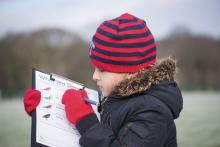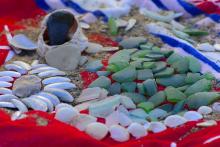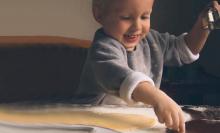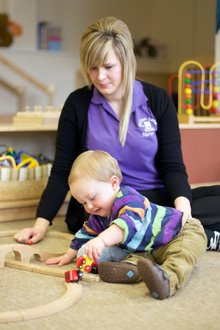Children begin exploring mathematical concepts from birth. Very young babies learn about the shape and size of objects when they suck toys and other objects, and are learning about size, shape and weight when they are developing their abilities to grasp and pick up objects. Baby toys such as stacking cups, shape sorters, simple puzzles and Russian dolls are an introduction to matching, comparing and ordering. And the first songs they learn are often full of counting (think of Once I Caught a Fish Alive or This Old Man) or subtraction (Five Little Ducks or Ten in the Bed).
Exploring maths with young children shouldn't be about sums - focus instead on learning about number, shape, size and pattern through everyday activities. This will help children develop their reasoning and problem solving skills – and you can have some fun in the process!
Home-grown maths
Snack time is a great opportunity to learn about maths. Can your child get out the right number of plates and cups? Can they divide a cake in half or a sandwich into quarters? Can they share out breadsticks or grapes so everyone has the same number?
Try bringing maths into the bath too. Pop in some cups and jugs and see if your child can fill them halfway, or estimate how many cupfuls will fill the jug. What shapes and patterns are in the bath tiles? How many bottles of shampoo and shower gel are there, and can your little one put them into size order?
Cooking is one of the best activities for early numeracy. Making simple muffins requires recognising the numbers in the recipe, weighing the flour, counting the eggs, measuring out the oil, arranging the cases in the muffin tray, setting the oven at the right temperature, setting the timer, and counting how many tasty treats you have at the end.
Even household chores can develop maths skills. As you sort a basket of clean laundry together, see if your child can put the socks into pairs, match the right size T-shirt to the right family member and judge who has the biggest pile of clothes at the end. Or ask them to lay the table for lunch, choosing the right number of knives, forks and spoons and putting them in the right places.
Maths games and toys
Many traditional games are great for developing mathematical skills. Hopscotch, skittles, dominoes, playing cards, or dice and board games – ludo or snakes and ladders for instance – all encourage number recognition and counting. If you have Lego or similar types of building bricks your child will be exploring fractions when they discover that an 8-brick is the same size as two 4-bricks or four 2-bricks, play with sequences and patterns by building a tower using a repeated pattern of bricks or develop their understanding of number when they count the number of wheels they need to complete their car.
Why not make your own maths games? Mark out some numbered parking spaces on a tray or table and put different numbers of dots on top of your child's toy cars, then ask them to park the cars in the right spaces. Or stick a different number on each of your stairs and take turns standing at the bottom and trying to throw the right number of bean bags (or scrunched up paper balls or rolled up socks) onto the right step.
You might want to build up a collection of maths 'tokens' – small objects that children can use for sorting, matching and counting. Shells, buttons, conkers, bottle lids, pasta shapes and pebbles are all perfect for this, although you will of course need to be aware of any possible choking hazards. Give your child some tokens and an ice-cube tray, muffin tin or egg box and watch how they sort and count the objects into the different compartments.
You can bring lots of maths into role play too. Setting up a pretend shop or cafe means finding or making a till and money, price labels, menus and signs. If possible, use some real coins, receipts, takeaway menus and old credit cards in the game. Talk about the numbers on them and what they mean. Can your child spot dates, times, prices and phone numbers?
Outdoor Maths
When you're out and about, encourage your child to be a number detective. Decide on a number (their age is a good one to start with) and see how often they can spot it on signs, houses, vehicles – everywhere! You could do the same with shapes – first 2D shapes such as circles and triangles, and then 3D shapes like spheres and cuboids.
Once they're familiar with a number or shape, they might want to have a go at writing or drawing it. This doesn't have to be with pen and paper – it could be with a stick in sand, chalk on a patio or a finger in a tray of shaving foam. Don't worry if their efforts still need some practice. At this age maths should be about more about exploring and experimenting than about right and wrong.
All of these activities offer rich opportunities for developing your child’s maths-related vocabulary in real-life contexts
Most importantly, have fun together!
Written for the Early Years Alliance by Elyssa Campbell-Barr.







